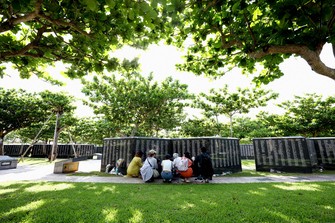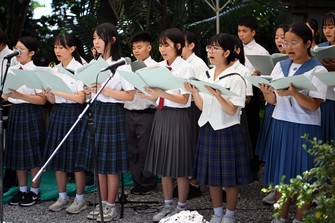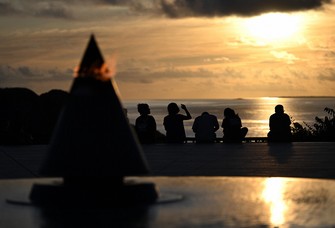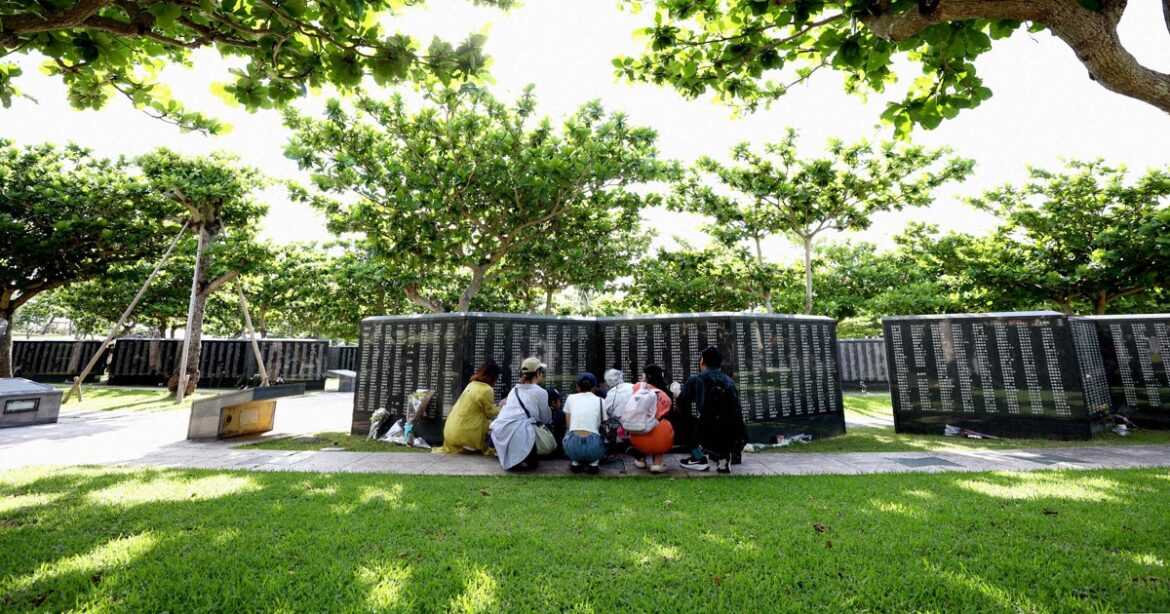
Mutsumi Nakasone and her family members put their hands together in prayer in front of the Cornerstone of Peace in Itoman, Okinawa Prefecture, on June 23, 2025. Mutsumi’s grandmother, Ushi Higa, and others died in the 1945 Battle of Okinawa, and Mutsumi took her five grandchildren to the monument to mourn their souls that day. (Mainichi/Shinnosuke Kyan)
Okinawa on June 23 observed “Memorial Day,” marking the day 80 years ago when organized combat between the then Imperial Japanese military and U.S. forces is said to have ended. We must never forget the history of forcing a tremendous sacrifice upon Okinawa residents due to the gruesome ground battle waged in the final phases of World War II.
During the war, the Japanese military made Okinawa a “sacrificial stone” to buy time to prepare for decisive battles on mainland Japan. After the fall of its command headquarters in Shuri, present-day Naha, the Japanese military continued to resist while retreating to the south of Okinawa’s main island, embroiling numerous residents in the fighting.
Of the approximately 188,000 deaths on the Japanese side, half were residents. The Japanese military’s attitude of prolonging the fighting without hesitating civilian sacrifices has left a lingering sense of distrust among Okinawa Prefecture residents.
What is concerning is that there are moves to turn people’s eyes away from this history.

Children sing a song ahead of a memorial service at the Himeyuri Cenotaph in Itoman, Okinawa Prefecture, on the morning of June 23, 2025. (Mainichi/Kaho Kitayama)
The past must never be distorted
An epitome of such moves was the remarks made by Shoji Nishida, a Liberal Democratic Party lawmaker of the House of Councillors, at a meeting held in Naha this May.
Regarding an exhibit at the Himeyuri Cenotaph in Itoman, erected in memory of female students and their teachers who perished in the Battle of Okinawa after being mobilized as nurses into the Himeyuri Student Corps, Nishida unilaterally claimed that there were descriptions to the effect that, “The Japanese military rolled into the area, leaving the Himeyuri corps to die. Then the U.S. troops came in, setting Okinawa free.” He criticized the exhibit as “rewriting history,” and also stated, “Japan cannot become independent unless we create a history that we can be convinced of.”
Of the 136 Himeyuri corps members who died, more than 80% lost their lives after being thrown out into the battlefield following a Japanese military order for the corps to disband. Nishida’s remarks do not reflect the realities of the Battle of Okinawa and are unacceptable.
Fumiaki Nozoe, a professor at Okinawa International University who specializes in Japanese diplomatic history, pointed out, “Mr. Nishida’s remarks distort the facts. Okinawa residents are harboring a feeling of alienation that the history of Okinawa has not been shared with mainland Japan, and are becoming increasingly concerned that wars could be repeated again.”
It is precisely because of these circumstances that the importance of passing down the experiences of the war is ever growing. With the war generation dwindling, young people’s activities to convey wartime records and survivors’ testimonies have come under the spotlight.
Nitsuki Karimata, 27, launched Savira, a company providing peace studies program for school trips, with her peers. The program not only introduces the testimonies of survivors while guiding students at former battle sites, but also provides an opportunity for them to discuss themes such as “what is needed for building peace.”
Karimata started the firm after finding the peace education she received was insufficient. “Even when people who experienced the war shared their valuable stories, it was hard to understand without advance knowledge. I also wanted a clear explanation for why the war had started,” she recalled. Through her activities, she has increasingly felt, “It is important to not ignore the past. We must pass on the lessons even 100 years, or 200 years after the war.”

People gaze at the sea in Mabuni near the Flame of Peace at Peace Memorial Park in Itoman, Okinawa Prefecture, on June 23, 2025. (Mainichi/Kaho Kitayama)
Japan must take Okinawa’s burden as its own affair
Even after 80 years have passed since the end of the war, Okinawa’s “postwar” period has not ended. The prefecture has continued to face “structural discrimination,” being forced to host U.S. military bases in the name of maintaining security, inflicting burdens on residents.
During the 27 years of U.S. military rule of Okinawa before its reversion to Japan, residents were deprived of their land through heavy-handed tactics for the construction of bases. Even today, about 70% of U.S. military-exclusive facilities in Japan are concentrated in Okinawa in terms of land area, including airfields and maneuver areas.
In disregard of Okinawa residents’ calls for reducing the burden of hosting the bases, the Japanese government has been pressing ahead with the planned relocation within Okinawa of U.S. Marine Corps Air Station Futenma to the Henoko district of Nago. In a 2019 prefectural referendum, 70% of voters opposed the land reclamation of areas off Henoko for the construction of the new base.
There is also no end to sex crimes committed by U.S. servicemen in Okinawa. The Japanese government has nevertheless failed to tackle the revision of the Japan-U.S. Status of Forces Agreement, which has hindered prosecution of U.S. military personnel in the country. Cases also emerged where the Japanese government and Okinawa Prefectural Police did not inform the Okinawa Prefectural Government of those incidents. Such actions that ignore the victims’ human rights are unacceptable.
The U.S. military bases that were installed in mainland Japan in the wake of the country’s defeat in the war have subsequently been consolidated and compacted, yet Okinawa continues to bear a heavy burden. Professor Nozoe urged, “More of the U.S. military training in Okinawa should be hosted by mainland Japan to help reduce Okinawa’s burdens.”
As China steps up its maritime advancements, a number of new Japanese Self-Defense Forces bases have been established on Sakishima Islands in Okinawa. A plan to evacuate Sakishima residents to Kyushu and elsewhere in the event of contingencies in Taiwan was also announced. The government should listen to the backlash by local residents harboring concerns that Okinawa could once again be the target of military attacks.
What is required now is to treat Okinawa’s security burden not as a local issue but as Japan’s own problem. Facing up to the history and realities of the Battle of Okinawa will be the starting point for these endeavors.


AloJapan.com